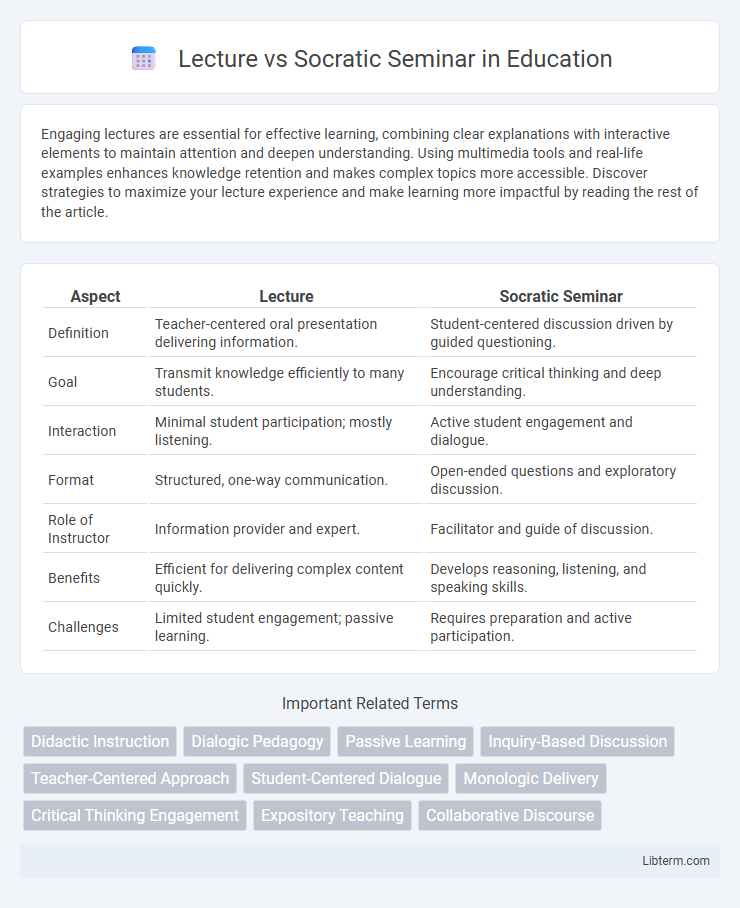Engaging lectures are essential for effective learning, combining clear explanations with interactive elements to maintain attention and deepen understanding. Using multimedia tools and real-life examples enhances knowledge retention and makes complex topics more accessible. Discover strategies to maximize your lecture experience and make learning more impactful by reading the rest of the article.
Table of Comparison
| Aspect | Lecture | Socratic Seminar |
|---|---|---|
| Definition | Teacher-centered oral presentation delivering information. | Student-centered discussion driven by guided questioning. |
| Goal | Transmit knowledge efficiently to many students. | Encourage critical thinking and deep understanding. |
| Interaction | Minimal student participation; mostly listening. | Active student engagement and dialogue. |
| Format | Structured, one-way communication. | Open-ended questions and exploratory discussion. |
| Role of Instructor | Information provider and expert. | Facilitator and guide of discussion. |
| Benefits | Efficient for delivering complex content quickly. | Develops reasoning, listening, and speaking skills. |
| Challenges | Limited student engagement; passive learning. | Requires preparation and active participation. |
Introduction to Lecture and Socratic Seminar
Lecture methods emphasize direct instruction where the teacher delivers structured content, focusing on clarity and efficiency in transmitting knowledge. The Socratic Seminar centers on collaborative dialogue, encouraging students to engage critically through open-ended questions and reflective thinking. Both approaches aim to foster understanding but differ in interaction style and student participation.
Defining the Lecture Method
The lecture method is a traditional instructional approach where an expert orally delivers content to students, emphasizing passive learning and information transmission. It structures knowledge through a one-way communication model, often supported by visual aids such as slides or notes. This method prioritizes efficient coverage of material but may limit interactive engagement and critical thinking opportunities.
Understanding the Socratic Seminar Approach
The Socratic Seminar approach emphasizes critical thinking through guided dialogue, encouraging students to engage deeply with texts by asking open-ended questions and exploring diverse perspectives. Unlike traditional lectures that prioritize passive information delivery, Socratic Seminars foster active participation, collaborative inquiry, and the development of reasoning skills. This method enhances comprehension and retention by creating an interactive learning environment where meaning is constructed collectively.
Key Differences Between Lecture and Socratic Seminar
Lectures deliver information through instructor-led presentations, emphasizing content transmission and note-taking for student learning. Socratic Seminars prioritize critical thinking and dialogue, encouraging students to explore ideas through open-ended questions and collaborative discussion. The key difference lies in passive knowledge reception in lectures versus active, student-driven inquiry in Socratic Seminars.
Advantages of the Lecture Method
The lecture method efficiently delivers large volumes of information to diverse audiences, ensuring consistent and structured content presentation. It allows educators to maintain control over the pacing and depth of the material, making it ideal for complex subjects requiring clear explanations. This approach also supports the incorporation of multimedia tools to enhance engagement and retention during instruction.
Benefits of the Socratic Seminar
The Socratic Seminar enhances critical thinking and deepens understanding by encouraging students to engage in open dialogue and explore multiple perspectives. This method promotes active listening, collaboration, and the development of articulate reasoning skills, contrasting with the passive reception often experienced in lectures. By fostering a learner-centered environment, Socratic Seminars cultivate intellectual curiosity and autonomy.
Common Challenges in Lectures vs. Seminars
Lectures often face challenges such as passive student engagement, limited interaction, and difficulty in addressing diverse learning paces, leading to reduced retention and comprehension. Socratic seminars struggle with ensuring equal participation, managing dominant voices, and fostering critical thinking without clear guidance, which can limit depth of discussion. Both formats require strategies to enhance involvement and tailor communication to avoid disengagement and superficial understanding.
Ideal Subjects for Each Teaching Style
Lectures are ideal for subjects requiring the efficient delivery of foundational knowledge or complex theories, such as science, mathematics, or history, where content accuracy and breadth are essential. Socratic Seminars excel in humanities and social sciences like literature, philosophy, or ethics, fostering critical thinking through dialogue and exploration of multiple perspectives. Selecting the appropriate teaching style depends on whether the objective is knowledge transmission or cultivating analytical debates.
Enhancing Student Engagement: Lecture vs. Socratic
Socratic seminars enhance student engagement by encouraging critical thinking and active dialogue, fostering deeper comprehension through question-driven discussions. Lectures primarily deliver information passively, often limiting interactive participation and diminishing opportunities for students to articulate their reasoning. Incorporating Socratic methods in classroom settings significantly boosts intellectual involvement by promoting inquiry and collaborative analysis.
Choosing the Right Approach for Effective Learning
Choosing the right approach for effective learning depends on the goals and dynamics of the classroom; lectures provide structured delivery of information, ideal for introducing new content and ensuring coverage of essential topics. Socratic seminars encourage critical thinking, dialogue, and in-depth exploration of ideas, fostering student engagement and collaborative analysis of complex subjects. Integrating both methods strategically can optimize knowledge retention and develop higher-order cognitive skills in diverse learning environments.
Lecture Infographic

 libterm.com
libterm.com